Training Energy Systems: The Climbers Guide
Whether you have been training for 5 years, or are just starting out, the phrase “energy systems” will likely be on your radar. Energy system training, along with finger strength development, forms the backbone of forearm physiology.
Information about how to improve these attributes is widespread in climbing training media and resources, but exactly how we use and train “energy systems” to achieve a goal can be confusing. Training at different intensities that don’t mimic our climbing goal can seem unintuitive and it can be hard to grasp how these exercises may improve our climbing performance. The topic of energy systems is further confused by the fact that different sports rarely agree on, or use the same terminology, making transfer of information difficult and leading to misconceptions.
In climbing the limiting muscle is often, though not always, our forearms. This means we often focus on the forearms when it comes to energy system profiling and training for climbing (for example, using a fingerboard).
The Building Blocks Of Energy Systems – ATP
When we take a climbing hold in our grip (no matter whether it is a crux crimp or a resting jug), a molecule called ATP provides the energy to contract our muscles. We can only store a small amount of ATP in our muscles, so in order to meet the demand of increased physical activity we have a number of processes in our cells that allow us to produce ATP on a supply-and-demand basis.
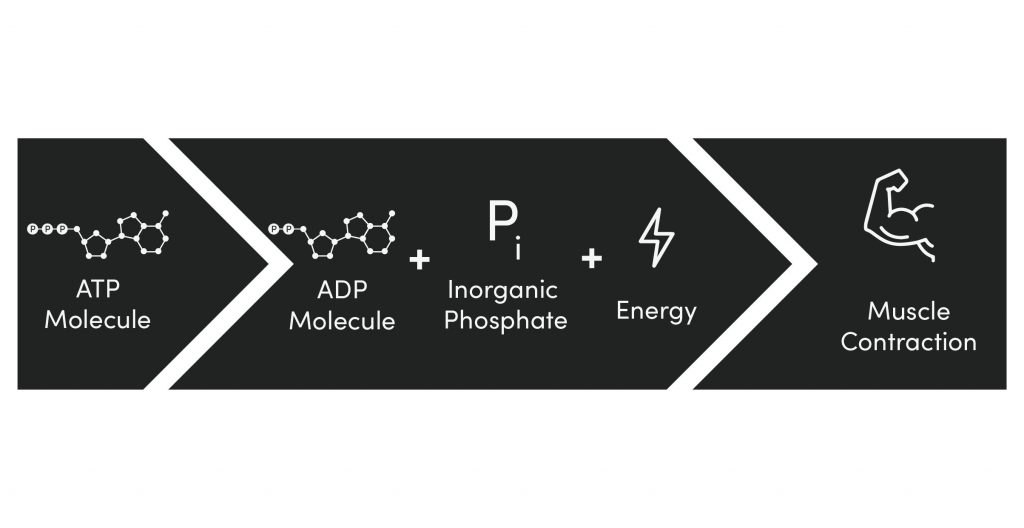
We have 3 different pathways by which we can produce ATP. These different pathways produce ATP at different rates, such that we can apply ourselves to a range of different intensities and durations of exercise. As you will have likely discovered, you cannot sustain extremely intense exercise for a very long period of time, whereas you can complete moderate or low intensity exercise for much longer. This relationship between intensity and duration of exercise is explained by the different energy systems and how they work.
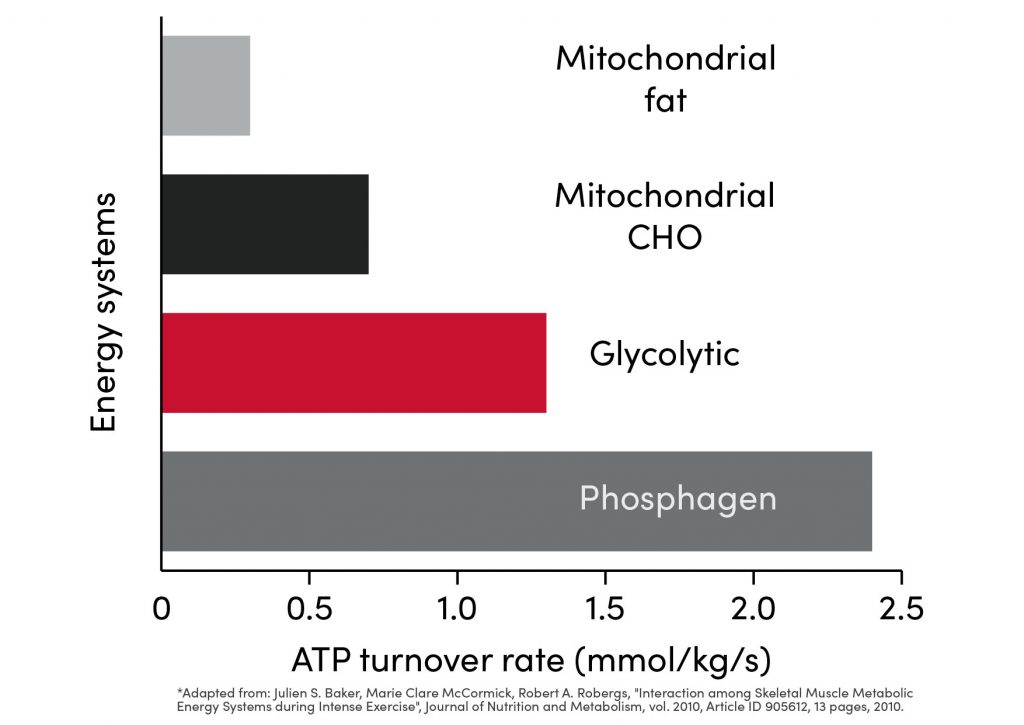
So what are these energy systems?
We have two pathways that make up our energy systems; the anaerobic and aerobic pathways. Our anaerobic system is made up of two pathways; the alactic and lactic pathways. Our anaerobic energy systems produce ATP without the use of oxygen and the pathways are composed of fewer steps/reactions, which leads to a faster rate of ATP production. Although our anaerobic systems can produce ATP quickly, they do not have the capacity to produce very large amounts of ATP in a sustainable way. On the other hand our aerobic system is made up of many steps, is slower to produce ATP, but has the capacity to produce large amounts of ATP in a sustainable way. The anaerobic pathways take place in the cytoplasm, whereas the aerobic pathway is housed in the mitochondria.
This brings us to one of the common misconceptions. We can be led to think that our different energy systems work in isolation, in a sequential manner. Some diagrams show the different energy systems working for set amounts of time with the idea of a “switch” between them. Our energy systems do not work in isolation, they work together in a coordinated response to an increased energy demand in the muscle. This is especially important to understand in climbing, as an intermittent and varied intensity sport (rather than an all out sprint). However, this does not mean they all contribute equally when it comes to different intensities and durations of exercise/climbing.
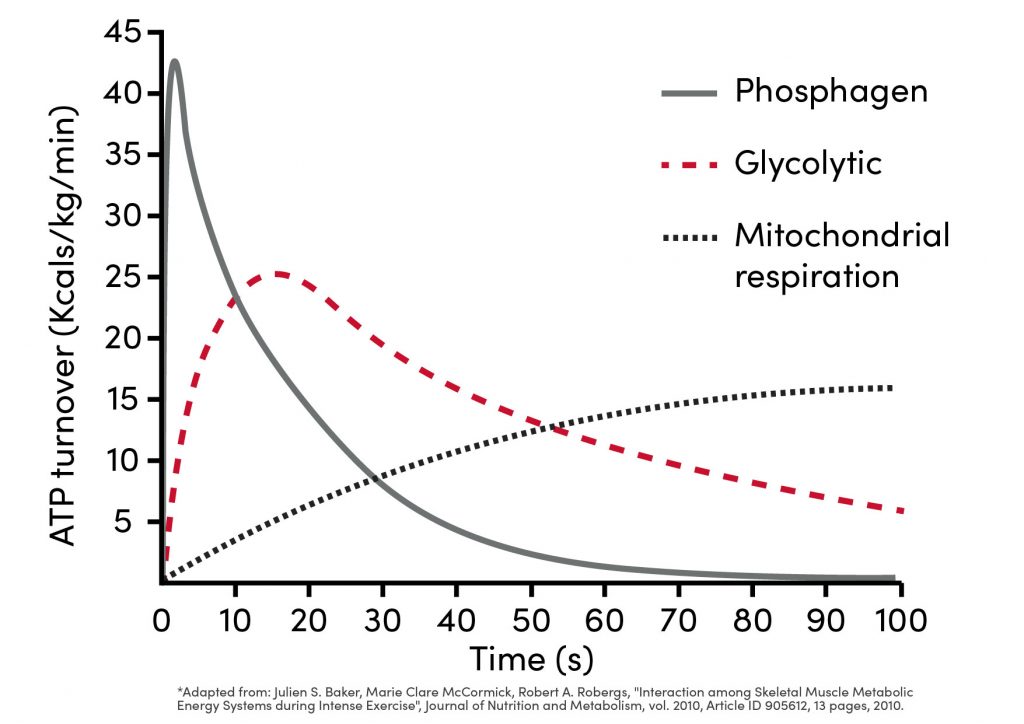
Energy system interaction and the differences in rates of ATP turnover during short term intense exercise to fatigue. The data presented is original, theoretical, and based on the authors’ assessment of contemporary research evidence.
Although our energy systems don’t work in isolation, different systems will be dominant at certain intensities. This is why we can use intensity and duration to guide our energy system training. By setting the intensity of training high, we will force our muscles to produce ATP quickly, and therefore our anaerobic systems will dominate. By setting the intensity of training low, we allow our aerobic system to contribute more as a slower rate of ATP production will still allow the demands of the exercise to be met. When we produce ATP via the aerobic system the process is more sustainable (doesn’t lead to build up of metabolites that reduce muscle function) and so we can sustain the exercise for longer. These are the underlying concepts that help us arrive at the infographic below.
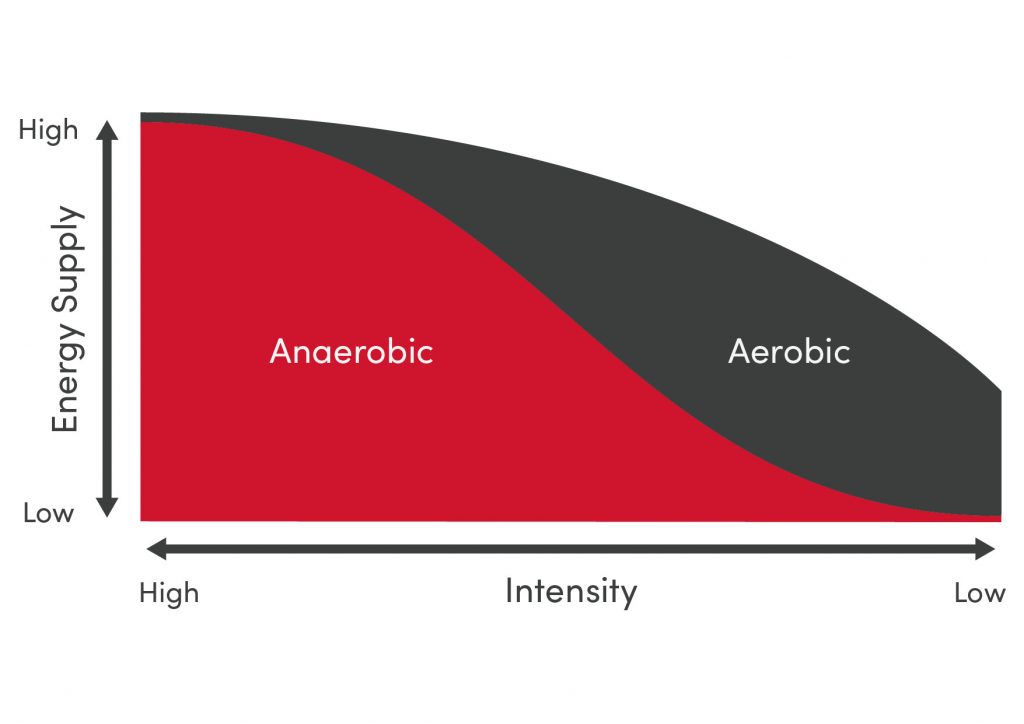
How Do Energy Systems Contribute To Our Climbing?
Having covered the fundamental concepts with regard to energy systems, let’s explore how this actually plays out in our climbing. When we start to exercise, our muscles set about producing ATP to try and maintain homeostasis. If we cannot supply ATP at the rate needed to sustain the intensity of exercise then we will start to see reduced performance. In some cases, for example in cycling or running, this may be experienced as having to slow down, however in climbing this is generally experienced as falling off. This is because we don’t have the same ability to “slow down” given that the challenge level is generally set in stone (mind the pun). A running analogy would be setting a treadmill at a fast speed, and having someone run on it until they can no longer meet the speed requirement and they come flying off.
A lot of the climbing we do is near our limit and as such our anaerobic systems will play a large role in ATP production. This is why in most climbing scenarios we are “on a timer” and we could not sustain the level of climbing for a very long period of time. When we exercise at an intensity that requires fast ATP production via the anaerobic systems, “failure” or the inability to sustain the force is inevitable.
Why is this?
The main things that limit the anaerobic pathways are; “not enough fuel” and “too many metabolites” (byproducts of the reactions). The concept of “not enough fuel” is relatively simple: as the amount of PCr or glucose/glycogen declines the rate of ATP production via the anaerobic systems is reduced. The reason behind “too many metabolites” requires a deeper dive. Historically, the production of lactate has been associated with muscle fatigue during high intensity exercise. The current perspective on this has changed, and it is now thought that inorganic phosphate (the high energy phosphate that is cleaved from ATP to form ADP and energy) is responsible for the reduced force seen over time when using our anaerobic systems.
As we have seen there is a spectrum of energy system contribution at different intensities and durations, and as such there are different “feelings” associated with these modes of exercise. Common expressions to describe this muscle fatigue in climbing are “power out” and “pump”, and these generally indicate we are using our anaerobic systems to contribute to ATP production (though to varying extents).
What about the intermittent nature of climbing?
When we climb we do not contract our forearms in a constant way. Climbing is intermittent in terms of contractions because we always have to relax to release our grip and move between holds. What happens in this period of relaxation? We allow full blood flow to our forearm muscles to deliver oxygen and remove metabolites from anaerobic ATP production that, if accumulated, impede muscle function. We can shift these metabolites into the mitochondria and use ATP from the aerobic system to replenish our anaerobic systems (i.e. resynthesis of PCr). This is the way in which a well developed aerobic system helps to complement our anaerobic systems, as we can replenish them more readily in times of rest. The delivery of oxygen and removal of metabolites relies on a dense system of capillaries. When we talk about training our aerobic system, we can lean towards thinking about the intracellular processes, but what is going out outside the cell is also a very important factor when it comes to applying our energy systems in climbing. To read more about capillarisation, head to this article.
This recovery interval of climbing is mirrored in repeater-style training protocols. These rest periods may seem short but they can be very influential in terms of performance. This is in part explained by the nonlinear rate of PCr resynthesis in a rest period, which occurs at a very fast rate initially and slows over time.
At this stage, let’s take a step back and revisit the main concepts of training energy systems for climbing;
- Our energy systems work together to provide ATP for muscle contraction
- When we work at higher intensity we require a faster rate of ATP production to generate the force which means our anaerobic systems are dominant
- As we reduce the intensity, our aerobic system can contribute more to the ATP production, making the force more sustainable
- Our aerobic system allows us to replenish our anaerobic systems in times of rest or sufficiently low intensity work as the metabolites can be taken into the mitochondria as well as removed into capillaries, and PCr can be synthesised using ATP from our aerobic system
- A higher degree of capillarisation results in improved ability to deliver oxygen to the muscle and remove metabolites
An analogy to understand energy system contribution
We can use an analogy to help us understand how energy systems work together in a coordinated response.
This analogy refers to our “anaerobic capacity” and “aerobic capacity” in different scenarios. As previously mentioned, there is varying terminology when it comes to energy systems. For the purpose of this analogy, our “anaerobic capacity” refers to the amount of work we can do above our aerobic level and our “aerobic capacity” refers to the ability to produce ATP and buffer anaerobic byproducts. We will not dive into the complexity of what these terms represent physiologically here.
- The water flowing out of the bottom of the tank is the force we are producing. The greater the flow of water, the higher the force, and the more difficult the climbing.
- The level of water in the tank represents our anaerobic capacity. This dictates the amount of work we can do above a certain intensity. A high outflow would rapidly decrease our anaerobic reserves. It is possible for us to replenish this capacity at rest/relative rest.
- The water flowing into the tank represents our aerobic capacity. The greater the flow of water into the tank, the better developed our aerobic system is, and the greater the force (level of climbing) we can sustain without depleting our anaerobic capacity.
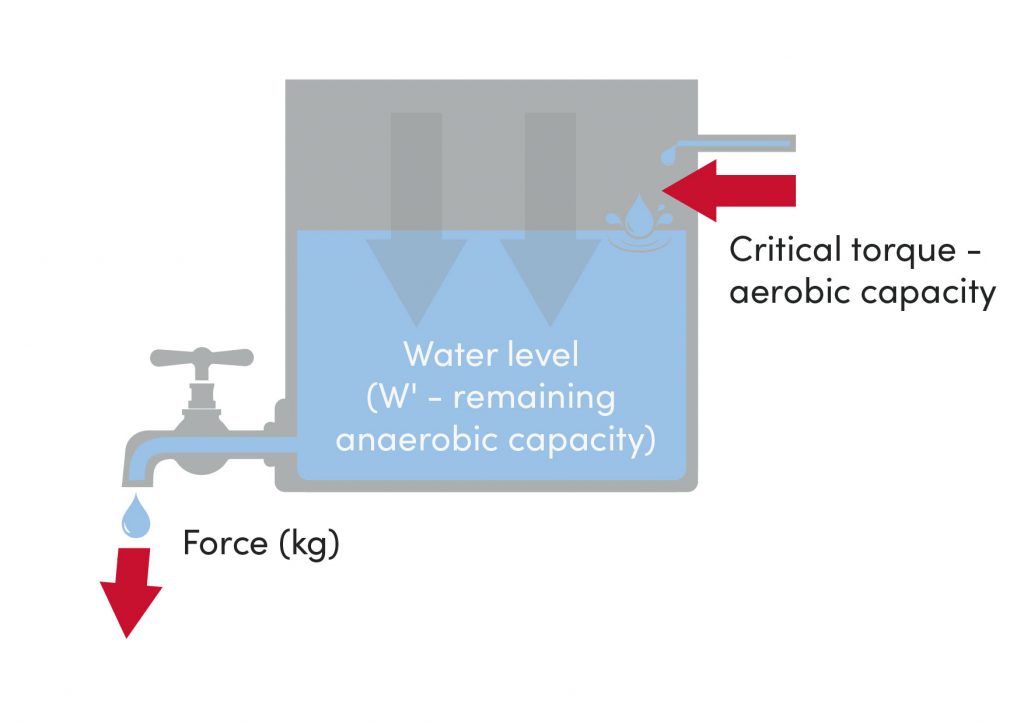
Let’s look at a few scenarios that we can use to transfer this analogy to our climbing;
- If “water out = water in” then we are climbing at a level that can be sustained by our aerobic capacity. This does not necessarily mean we won’t use any anaerobic capacity, BUT any anaerobic work can be replenished by our aerobic system such that there is no net accumulation of metabolites. Reducing the intensity will mean we are well within our aerobic ability, and increasing it will mean we need to use our anaerobic capacity. Climbing at this level will still get tiring after a long duration, but we will not experience imminent “pump” or “power out”. For example, this could be vertical climbing around 5a for a 8a climber. Alternatively, this may be completing 30% repeaters where no pump is built throughout the sessions and the final reps feel approximately the same difficulty as the first reps. A climber would walk away from training at this intensity feeling relatively fresh.
- If the “water out > water in” then we are climbing at an intensity that requires us to rely on our anaerobic capacity. The water in the tank will be going down at a rate correlating with the intensity of climbing. The harder the climbing, the greater the rate of flow out of the tank, the faster the depletion of the water tank and the less time we can sustain the force for. This category of “water out > water in” is a broad one, and spans training scenarios from “strength” to “anaerobic capacity” and “aerobic power” that are often seen in climbing, as in all of these scenarios there is a significant contribution from the anaerobic system
- Reaching a rest where “water out < water in” after a phase of depleting the water tank. After climbing a sequence that requires us to use our anaerobic capacity, there will be less water in the tank. If we then arrive at a rest that allows us to exert a low enough force, the flow of water out of the tank will slow. If this outwards flow of water becomes slower than the inwards flow, we are able to recover and replenish our anaerobic capacity. Further developing our aerobic system, allows us to more quickly recover at rests, and recover at poorer rests.
Still got questions? Join our coaches in Lattice 365, our members only Facebook forum giving you 24/7 access to Lattice Coaches.






